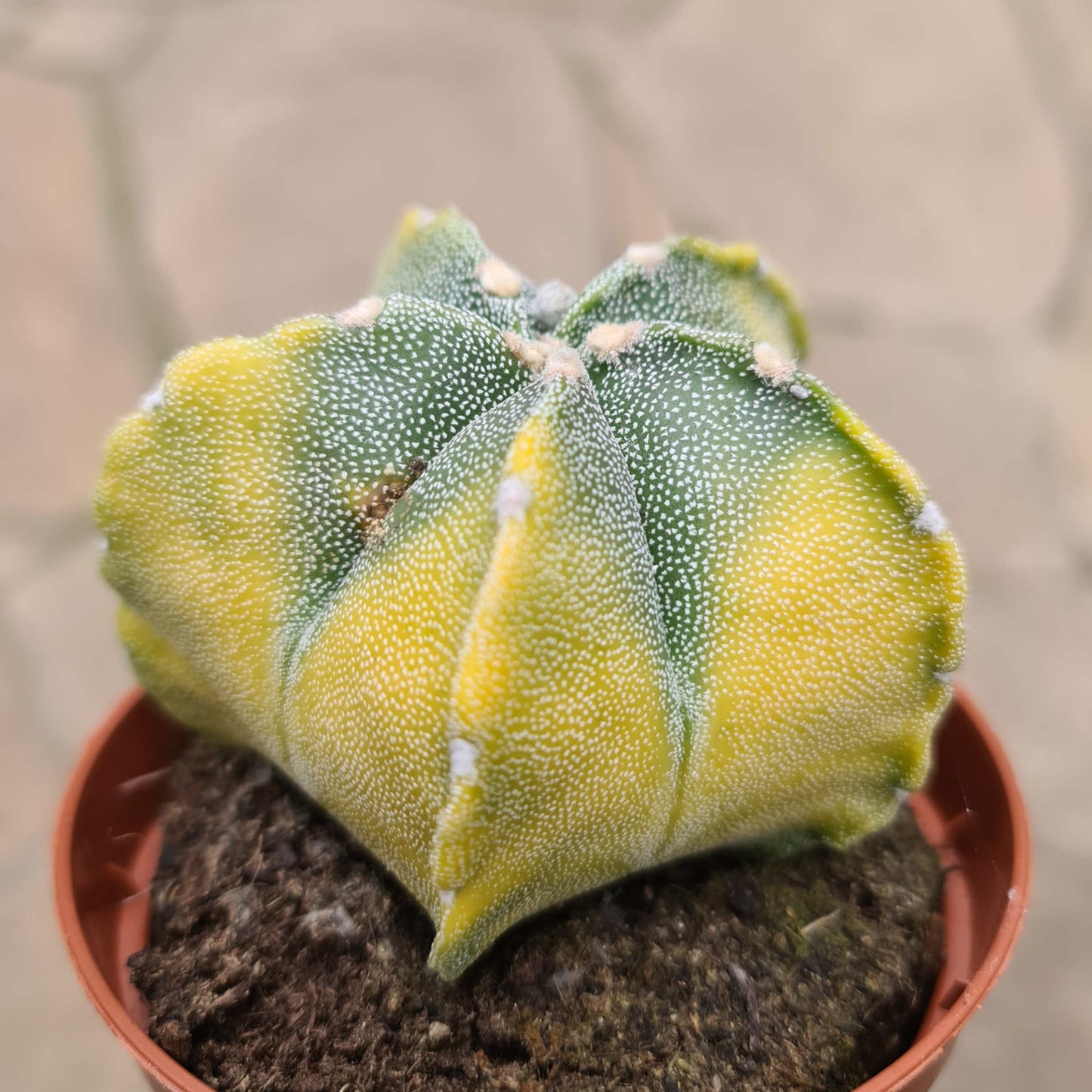VIRIAR
Astrophytum myriostigma « Variegata » – Cactus à chapeau d'évêque panaché – 10 graines
Astrophytum myriostigma « Variegata » – Cactus à chapeau d'évêque panaché – 10 graines
Impossible de charger la disponibilité du service de retrait
Nom : Astrophytum myriostigma « Variegata »
Noms communs : Cactus à chapeau d'évêque panaché, Cactus à chapeau d'évêque panaché
Astrophytum myriostigma « Variegata », communément appelé « Cactus à chapeau d'évêque panaché », est une espèce de cactus visuellement captivante, prisée pour son motif panaché unique et sa forme géométrique. Originaire des hautes terres du nord-est du Mexique, ce cactus appartient au genre Astrophytum , réputé pour sa forme étoilée et symétrique et ses points laineux recouvrant sa surface. La forme « Variegata » d' Astrophytum myriostigma est particulièrement recherchée pour son mélange saisissant de taches vertes, jaunes et crème qui ajoutent un intérêt visuel à toute collection de succulentes.
Ce cactus se distingue par ses côtes lisses et sans épines, généralement au nombre de cinq, qui forment une structure étoilée. Ces côtes sont ornées de minuscules aréoles blanches et laineuses, lui donnant un aspect moucheté. La plante atteint généralement une hauteur de 10 à 15 cm et un diamètre de 8 à 10 cm. À la fin du printemps et en été, Astrophytum myriostigma « Variegata » produit de petites fleurs jaune vif au sommet de la plante, qui peuvent durer plusieurs jours. Sa croissance lente et ses besoins d'entretien minimes en font un excellent choix pour les amateurs de cactus, débutants comme expérimentés.
Culture d'Astrophytum myriostigma « Variegata »
Conditions:
- Lumière : L'Astrophytum myriostigma « Variegata » s'épanouit en pleine lumière, indirecte et vive, ou en plein soleil. Un ensoleillement quotidien d'au moins 4 à 6 heures lui permet de conserver sa forme compacte et de mettre en valeur sa coloration panachée. Dans les climats plus chauds, un peu d'ombre l'après-midi peut contribuer à prévenir les brûlures.
- Température : Ce cactus préfère les températures chaudes et est particulièrement adapté aux zones de rusticité USDA 9 à 11. Il peut tolérer des températures aussi basses que -4 °C (25 °F) pendant de courtes périodes, mais doit être protégé des gelées prolongées. Dans les climats plus frais, il est préférable de le cultiver en intérieur ou en serre.
- Sol : L'Astrophytum myriostigma « Variegata » a besoin d'un terreau bien drainé pour cactus ou succulentes. Un mélange de terreau pour cactus, de perlite et de sable grossier assure un drainage et une aération adéquats, essentiels pour prévenir la pourriture des racines. Évitez les sols lourds et argileux qui retiennent l'humidité.
- Arrosage : Arrosez avec parcimonie, en laissant le terreau sécher complètement entre chaque arrosage. L’excès d’eau est la cause la plus fréquente de pourriture des racines. En hiver, réduisez la fréquence des arrosages à un toutes les 3 à 4 semaines, pendant la période de dormance de la plante.
Plantation et entretien :
- Plantation : Plantez l'Astrophytum myriostigma « Variegata » dans un contenant percé de trous de drainage pour éviter l'engorgement. Utilisez un terreau bien drainant et placez la plante à la même profondeur que dans son contenant précédent. Arrosez légèrement après la plantation pour tasser le sol et placez-la dans un endroit lumineux.
- Fertilisation : Fertilisez avec un engrais hydrosoluble équilibré, dilué de moitié pendant la saison de croissance (printemps et été). Fertilisez une fois par mois, mais évitez l'automne et l'hiver, lorsque le cactus est en dormance. Une fertilisation excessive peut entraîner une croissance rapide, ce qui peut fragiliser la structure de la plante.
- Entretien : Un entretien minimal est requis. Retirez toute partie morte ou endommagée pour préserver la santé de la plante. Inspectez régulièrement la plante pour détecter la présence de parasites comme les cochenilles ou les tétranyques, et traitez rapidement avec des insecticides adaptés ou des remèdes naturels.
Propagation
- Graines : L'Astrophytum myriostigma « Variegata » se multiplie principalement par graines. Récoltez des graines fraîches et semez-les dans un terreau bien drainé pour cactus. Conservez les graines dans un environnement chaud, à la lumière indirecte du soleil, et maintenez une humidité constante jusqu'à la germination, qui peut prendre plusieurs semaines, voire plusieurs mois. La panachure des semis peut varier, et tous les semis ne présentent pas ce caractère panaché.
- Greffage : Pour préserver les caractéristiques panachées et favoriser la croissance, le greffage sur un porte-greffe plus résistant (comme Myrtillocactus geometrizans ) est une méthode courante. Cette technique peut également améliorer la tolérance de la plante à différentes conditions de croissance et réduire le risque de pourriture.









